Alternatives to Grass
Alternatives to Grass
A neighborhood full of Kentucky Blue grass lawns is also a neighborhood full of sprinklers, mowers, fertilizers and weeds. Here are some of the many alternative ground cover plants that require less water, fertilizer, and maintenance. Most of these plants are low-growing, drought-resistant, and spread easily. But they are all attractive and long-lasting, too. You should till the soil and kill any perennial weeds before planting a new ground cover, but some of these varieties are weed-resistant and don't need rich, fertilized soil.
 Prairie Zinnia
Prairie Zinnia
Prairie Zinnia (Zinnia grandiflora) can turn a large, open patch of the yard into a beautiful, low maintenance flower garden. The plant creates a six-inch mat with bright yellow daisy-shaped flowers. Each plant only lasts two to three years, but the seeds spread and colonize a yard quickly. It forms a thick cover that blocks weeds. It never needs water after the first weeks of growth. In fact, it can't handle too much water and should only be planted in arid regions.
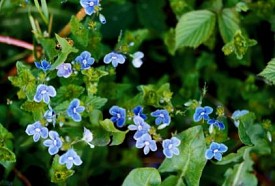 Blue Wooly Speedwell
Blue Wooly Speedwell
The Blue Wooly Speedwell (Veronica pectinata) creates a lovely deep green groundcover that lasts through the winter. Spring brings a profusion of small deep blue flowers. Some of the flowers survive all year, even with almost no water. The plant needs an occasional deep soaking and a quick trim of dead flowerheads to keep it pretty. It lasts in most any soil type, but works best in well-drained soils. It can beautifully cascade over a wall and handles some light shade. It is dense enough to block weeds and spreads quickly - so quickly that the edges may also need a trim once or twice a year.
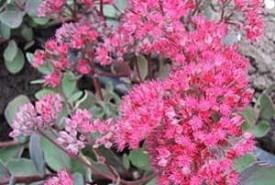 Showy Snowcrop
Showy Snowcrop
The Showy Snowcrop (Sedum spectabile) is also known as Autumn Joy and Live-Forever. It doesn't naturally spread very quickly but will last for many years with only moderate water. You can also encourage wider growth by cutting and replanting summer stems. It grows to about two feet, so it probably isn't ideal for an entire yard. In smaller areas, it adds beautiful fall color with late-blooming pink, red, or white flowers. The snowcrop does well in otherwise poor, sandy soil, and attracts butterflies and bees.
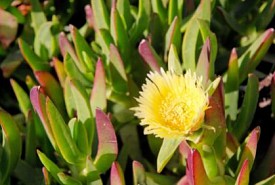 Hardy Yellow Iceplant
Hardy Yellow Iceplant
Iceplants are low-water groundcovers that spread quite quickly. The Hardy Yellow Iceplant (Delosperma Nubigenum) adds a unique look and color in the winter. It is also very drought-resistant. Small, succulent leaves (described as looking like jelly beans) turn from a deep green to a purplish red in colder months. In spring, hundreds of yellow flowers cover the plants, and blend in well with other spring flowers. The Hardy Yellow Iceplant isn't tropical or child-friendly - it won't survive heavy watering or foot traffic.
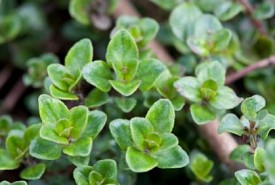 Wooly Thyme
Wooly Thyme
Don't eat wooly thyme (Thymus lanuginosus). Just watch it spread and grow small pink summer flowers, and enjoy the fragrance. All year, it has tiny felted dull green leaves. It only grows to about two inches and can handle some foot traffic, but probably not a back-yard football game. Like many of these hardy plants, fertilizers that help popular turf grasses survive have the opposite impact on wooly thyme. Overfertilizing wooly thyme can make the stems weak and spindly. Overwatering is also dangerous. It will rot the roots.
 Native Grass Seed Mixes
Native Grass Seed Mixes
Finally, a variety of native grass mixes are especially designed for the Southwestern United States and other arid regions. The lawn may look more like a natural prairie than a football field, but it will be filled with a variety of sizes and colors. The grasses last with less water and fertilizer, and are uniquely insect- and disease-resistant. Some mixes can be mowed to keep them short and walkable. Many blends are designed to grow in almost any soil type. Talk to a local nursery or lawn expert for recommendations suited to your climate.
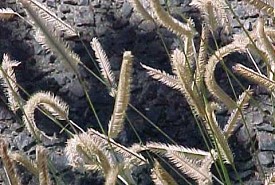 Blue Grama Grass
Blue Grama Grass
For a more traditional lawn, there are grass options that are more drought-resistant than Kentucky Blue. One favorite is the Blue Grama grass (Bouteloua Gracilis), which is dormant in winter, but thrives in the summer heat. Blue Grama grass can withstand poor soils, full sun and very little irrigation. It only needs 10 to 15 inches of water per year, and can either be mowed or left to grow naturally. It spreads slowly but forms hardy sod when mowed regularly. If left alone, it will grow to a natural height of 6 to 24 inches and mixes attractively with wildflowers. A couple of Blue Grama drawbacks: It is more expensive than some varieties; it struggles in the shade; and it can't withstand a lot of rough winter traffic. Photo credit: Belen, NM Chamber of Commerce.
Looking for a Pro? Call us (866) 441-6648

Landscaping Average Costs
Landscapers Experiences

Landscaping Turns A Weed Patch Into A Great Little Zen Garden

Yard Cleanup And Lawn Care Service With A Great Work Ethic



